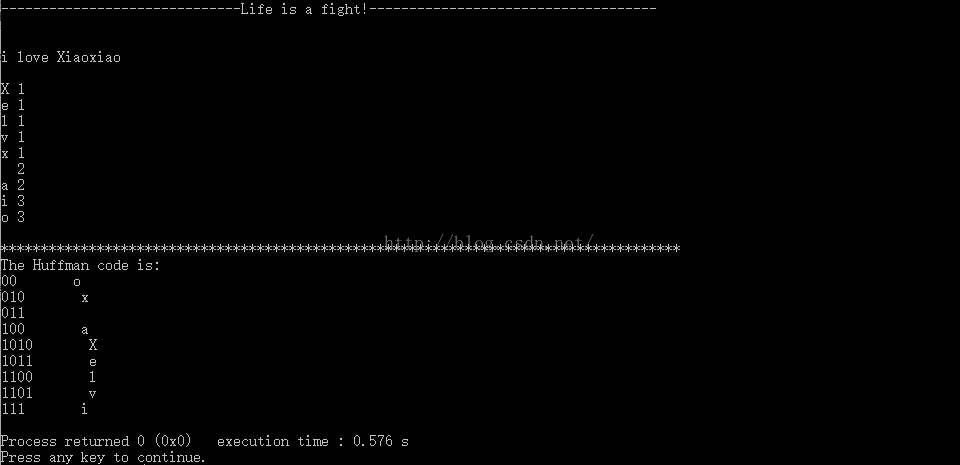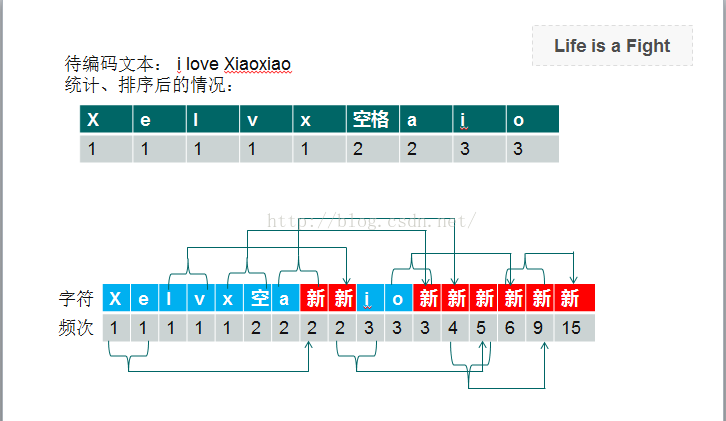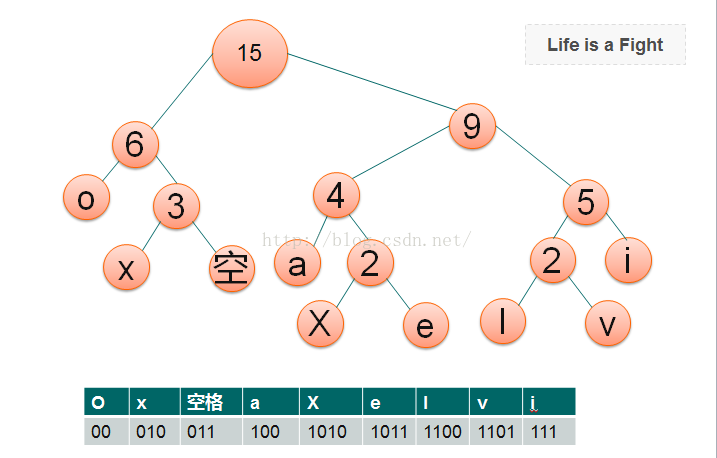1. 目标
读取一段字符,生成哈夫曼编码,并输出。如下所示:

2. 代码结构

2.1 统计各个字符出现的次数,并排序;

2.2 根据生成的哈夫曼树,生成哈夫曼编码;

3. 源代码
#include
#include
#include
#define title
#define queuesize_max 256 //队列的最大长度
#define code_max 256 //编码的最大长度
/**************************************/
/*定义huffman tree节点 */
/*其中symbol记录节点存储的字符 */
/*left, right指向左右子节点 */
/**************************************/
typedef struct hfmtreenode{
int symbol;
struct hfmtreenode *left;
struct hfmtreenode *right;
} hfmtreenode, *phtreenode;
/**************************************/
/*定义一个指向huffman tree的根节点 */
/**************************************/
typedef struct hhfmtreenode{
hfmtreenode* rootnode;
} hhfmtreenode;
/**************************************/
/*定义队列的节点 */
/*ptr是一个指向phtreenode的指针, */
/*主要是方便后续建立huffman treee */
/*count记录字符出现的频次, */
/*next指向下一个节点 */
/**************************************/
typedef struct queuenode{
phtreenode ptr;
int count;
struct queuenode *next;
} queuenode, *ptrqueue;
/**************************************/
/*定义指向queuenode的头节点 */
/*其中size记录节点的数量 */
/*first指向queuenode的第一个节点 */
/**************************************/
typedef struct hqueuenode{
int size;
ptrqueue first;
} hqueuenode;
/**************************************/
/*定义指向记录编码的table节点 */
/*symble为字符,code指向对应的编码 */
/*next用来指向下一个节点 */
/**************************************/
typedef struct tablenode{
char symbol;
char* code;
struct tablenode *next;
} tablenode;
/**************************************/
/*定义指向tablenode的头节点 */
/*first标记第一个节点 */
/*last指向最后一个节点 */
/**************************************/
typedef struct hdtablenode{
tablenode *first;
tablenode *last;
} hdtablenode;
/**************************************/
/*对队列进行初始,添加一个头节点 */
/*其中size记录节点的数量 */
/*first指向queue节点 */
/**************************************/
void initqueue(hqueuenode** hqueue)
{
*hqueue=(hqueuenode*)malloc(sizeof(hqueuenode));
(*hqueue)->size=0;
(*hqueue)->first=null;
}
void addqueuenode(hqueuenode **hqueue,hfmtreenode *hnode,int count)//新建一个队列节点并按统计的结果从小到大的顺序加入队列
{
queuenode *qnode=null;
if((*hqueue)->size==queuesize_max)//队列规模检查,正常情况下不会出现
{
printf("\nerr: the queue is full!!!");
}
else //如果正常,则按照从小到大的顺序,寻找正确的位置插入节点
{
if(0==(*hqueue)->size)//如果是添加的第一个节点,直接添加即可
{
qnode=(queuenode*)malloc(sizeof(queuenode));
(*hqueue)->first=qnode;
qnode->count=count;
qnode->ptr=hnode;
qnode->next=null;
(*hqueue)->size++;
}
else if(countfirst->count)//如果要添加的字符的统计数量小于现有最小的,则直接放在第一个节点处
{
qnode=(queuenode*)malloc(sizeof(queuenode));
qnode->next=(*hqueue)->first;
(*hqueue)->first=qnode;
qnode->count=count;
qnode->ptr=hnode;
(*hqueue)->size++;
}
else //对于第三类情况,则需要遍历队列,直到寻找到合适的位置
{
queuenode* p=(*hqueue)->first;
qnode=(queuenode*)malloc(sizeof(queuenode));
qnode->count=count;
qnode->ptr=hnode;
(*hqueue)->size++;
while(p->next!=null && count>=p->next->count)
p=p->next;
qnode->next=p->next;
p->next=qnode;
}
}
}
hfmtreenode* gethfmtreenode(hqueuenode* hqueue)
{
hfmtreenode* getnode;
if(hqueue->size>0)
{
getnode=hqueue->first->ptr;
hqueue->first=hqueue->first->next;
hqueue->size--;
}
else
{
printf("\nerr: can't get a node\n");
}
return getnode;
}
hhfmtreenode* crthfmtree(hqueuenode** hqueue)
{
int count=0;
hfmtreenode *left, *right;
while((*hqueue)->size>1)
{
count=(*hqueue)->first->count+(*hqueue)->first->next->count;
left=gethfmtreenode(*hqueue);
right=gethfmtreenode(*hqueue);
hfmtreenode *newnode=(hfmtreenode*)malloc(sizeof(hfmtreenode));
newnode->left=left;
newnode->right=right;
addqueuenode(hqueue,newnode,count);
}
hhfmtreenode* tree=(hhfmtreenode*)malloc(sizeof(hhfmtreenode));
tree->rootnode=gethfmtreenode(*hqueue);
return tree;
}
hhfmtreenode* creattree(void)
{
file *ifile;
int *countarray;
char c;
int i;
countarray=(int*)malloc(sizeof(int)*256);//分配空间用于存储各字符出现的次数,并初始化为零
for(i=0;i<256;i++)
{
countarray[i]=0;
}
ifile=fopen("d://1.txt","r");
if(!ifile) //检查文件是否打开成功
printf("can't open the file\n");
else
{
while((c=getc(ifile))!=eof)
{
countarray[(unsigned int)c]++;
printf("%c", c);
}
fclose(ifile);
}
hqueuenode *hqueue;
initqueue(&hqueue);
for(i=0;i<256;i++)
{
if(countarray[i])
{
//printf("%c %d\n",i, countarray[i] );
hfmtreenode *hnode=(hfmtreenode*)malloc(sizeof(hfmtreenode));//创建一个树节点,并初始化(用来对应队列queuenode中的ptr)
hnode->symbol=(char)i;
hnode->left=null;
hnode->right=null;
addqueuenode(&hqueue,hnode,countarray[i]);//将该节点插入队列中的适当位置(按统计的结果,从小到大排列)
}
}
free(countarray);//释放不用的内存
queuenode* q=hqueue->first;
printf("\n");
do
{
printf("\n%c %d",q->ptr->symbol, q->count);
q=q->next;
} while(q!=null);
//printf("%d",hqueue->size);
hhfmtreenode *tree=crthfmtree(&hqueue);
return tree;
}
void traversetree( hdtablenode** table, hfmtreenode* tree, char* code, int k)
{
if(tree->left==null && tree->right==null) //递归结束检查,即找到叶子节点
{
code[k]='\0'; //添加字符串结束标记
tablenode *tnode=(tablenode*)malloc(sizeof(tablenode)); //创建一个节点,并将其添加到table链表中
tnode->code=(char*)malloc(sizeof(char)*256+1);
strcpy(tnode->code,code);
tnode->symbol=tree->symbol;
tnode->next=null;
if((*table)->first==null) //如果是第一个节点,直接添加即可, 否则添加到尾部即可
{
(*table)->first=tnode;
(*table)->last=tnode;
}
else
{
(*table)->last->next=tnode;
(*table)->last=tnode;
}
}
if(tree->left!=null) //向左边递归,并记录编码为0
{
code[k]='0';
traversetree(table,tree->left, code, k+1);
}
if(tree->right!=null) //向右边递归,并记录编码为1
{
code[k]='1';
traversetree(table, tree->right, code, k+1);
}
}
hdtablenode* crttable(hhfmtreenode* hfmtree)
{
hdtablenode* hdtable=(hdtablenode*)malloc(sizeof(hdtablenode));
hdtable->first=null;
hdtable->last=null;
char code[code_max];
int k=0; //记录树的层级
traversetree(&hdtable, hfmtree->rootnode, code, k);
return hdtable;
}
int main(void)
{
hhfmtreenode* tree;
hdtablenode* table;
printf("%s\n\n\n",title);
tree=creattree();
table=crttable(tree);
int i=0, j=0;
tablenode* t=table->first;
char* s=t->code;
printf("\n\n*************************************************************************************\n");
printf("the huffman code is:\n");
while(t!=null)
{
for(i=0;i<257;i++)
{
if((*s)!='\0')
{
printf("%c",*s);
s++;
}
}
printf("%8c\n",t->symbol);
t=t->next;
if(t)
s=t->code;
}
}





















 1万+
1万+











 被折叠的 条评论
为什么被折叠?
被折叠的 条评论
为什么被折叠?








